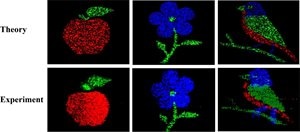Jan 25 2019
Scientists have developed a novel multicolor holography technology that can possibly be used for making 3D color displays for smartphones, augmented reality glasses¸ or heads-up displays without using any large optical components.
 Researchers developed a new way to create multicolored computer generated holograms. The experimental images they created matched well with the ones predicted by theory. The waveguide structures created using the new approach could offer easy integration and a form factor small enough for augmented reality and other displays. (Image credit: Zhiqin Huang, Duke University)
Researchers developed a new way to create multicolored computer generated holograms. The experimental images they created matched well with the ones predicted by theory. The waveguide structures created using the new approach could offer easy integration and a form factor small enough for augmented reality and other displays. (Image credit: Zhiqin Huang, Duke University)
Scientists from Duke University, USA, have reported their work in Optica, The Optical Society’s journal dedicated to high impact research. The team described how a multicolor image was encoded onto a 300 X 300 µm-hologram in a two-dimensional (2D) waveguide structure—an extremely thin structure that has the ability to guide light. The hologram generated by a computer creates intricate multicolor holographic images when blue, green, and red light illuminates the grating coupler.
“The hologram could be embossed directly onto the lenses of augmented reality glasses to project an image directly into the pupil of the eye without requiring any bulky lenses, beam splitters or prisms,” stated Daniel L. Marks, a member of the research team. “It could also be used to project a 3D image from a smartphone onto a wall or nearby surface.”
The latest fabrication technique is capable of encoding holograms in a material that is well-suited for built-in photonics technology. This implies that the advanced holographic devices are amenable to large-scale production using the same fabrication techniques used for producing computer chips. It is possible to integrate the hologram-generating elements into small chip-based devices that also accommodate the light sources needed for producing the 3D images.
From one color to three
The novel multicolor holography method is based on computer-generated holograms. Computer-generated holography produces interference patterns digitally, unlike conventional holography, which needs laser beams and a physical object to produce the interference pattern required for forming a holographic image.
Although high-resolution 3D images are provided by computer-generated holograms, it has been rather difficult to produce them in more than a single color. However, the Duke researchers solved this challenge by developing a binary hologram in a waveguide made of photoresist, a light-sensitive material, and a grating, which is a series of fringes. They subsequently devised a technique to incorporate the interference patterns for blue, green, and red into one binary hologram pattern.
One of the difficult parts of making a multicolor display is combining the colors and then precisely separating them to generate a full color image. With our approach this is all done all in one step on a single surface without any beam splitters or prisms. This makes it extremely amenable to integration into portable devices.
Zhiqin Huang, Study First Author, Duke University.
Another significant achievement was the creation of the holographic device in a waveguide. structure.
Others who have tried to create multicolor computer-generated holograms didn’t use a waveguide, which makes it a challenge to integrate the structure into a device. Our design offers easier and more flexible integration with a form factor small enough for augmented reality and other displays.
David R. Smith, Study Team Lead, Duke University.
Single-step color images
Using their novel holography technique, the investigators encoded interference patterns for static multicolor holograms of a bird, a flower, and an apple. All the holographic images, thus obtained, corresponded well with hypothetical predictions. Even though extremely small holograms were created for the demonstration, the technique can possibly be improved for creating larger displays, say the researchers. The team also believes that the new technique could even be integrated with current technologies, like those used for making liquid crystal displays, to generate dynamic images.
At present, the investigators are exploring ways to improve the technology by decreasing the light lost by the structures encoding the holograms. Integrating the structures into one integrated device with lasers would be needed to make the method practical, pointed out the researchers.